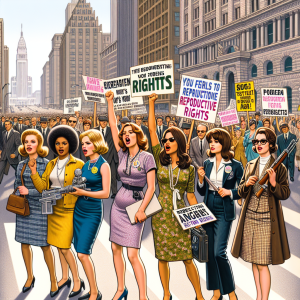#FutureGirls
The Genesis of a Revolution
The movement advocating for women’s rights did not suddenly appear; it evolved from a long-standing history of disparity, where female voices were stifled, their freedoms neglected, and their efforts minimized. This endeavor has been arduous and tortuous, highlighted by key victories and propelled by audacious souls who envisioned a transformative shift.
Essentially, the crusade for women’s rights embodies tenacity and fortitude. It focuses on breaking down the obstacles that impede women’s progress, aiming to guarantee that every woman can lead a life characterized by liberty and fulfillment. From securing the vote to championing for equal remuneration, this voyage has challenged societal conventions and advocated for legislative reforms that acknowledge women’s inherent rights.
The Forerunners of Revolution
The origins of this cause can be traced to the 19th century, a period when women commenced to vocally dispute their assigned societal positions. Among the pivotal events was the Seneca Falls Convention of 1848, organized by Elizabeth Cady Stanton and Lucretia Mott. This marked the inception of the official struggle for female suffrage in the United States. Here, the Declaration of Sentiments was authored, symbolizing the formal launch of the quest for women’s voting rights.
Nevertheless, the path to equality was fraught with hurdles. Throughout the 20th century, women persistently battled for their rights. Icons like Susan B. Anthony, Sojourner Truth, and Alice Paul stepped forward, each contributing distinctively to advance the movement. Despite facing considerable resistance and numerous disappointments, their determination was unshakeable.
The International Epiphany
While the nascent stages of the movement primarily concentrated on voting rights in Western nations, it rapidly broadened, acknowledging the global implications of women’s rights. As the 20th century unfolded, the United Nations became instrumental in championing gender equality. Significant gatherings, such as the International Women’s Year Conference in 1975 and the Beijing Declaration and Platform for Action in 1995, emphasized the world’s pledge to women’s rights, outlining detailed plans for advancement.
This worldwide enlightenment towards women’s rights also illuminated the varied difficulties women encounter across the globe, from battling gender-based violence to striving for reproductive freedom and securing equal seats in political and economic arenas. Activists like Malala Yousafzai and Leymah Gbowee have epitomized this expansive, inclusive perspective of the movement, underscoring education and peace as foundations of gender equality.
The Modern Voices
In today’s era of digital connectivity, the campaign has discovered novel platforms and fresh hurdles. Social networks have emerged as potent mediums for awareness and advocacy on behalf of women’s rights. Movements such as #MeToo and #TimesUp have demonstrated the strength of unity, spotlighting sexual misconduct and demanding accountability from offenders.
Yet, the quest for justice persists. Women globally continue to encounter prejudice, aggression, and disparity. The evolution of the movement illustrates that progress is attainable but necessitates ongoing dedication, camaraderie, and the bravery to speak out against disparities.
“Our journey is anchored in the legacies of giants, yet our battle rages on. It’s a time when every voice must resonate, when every woman must acknowledge her rights and her capacity.” – Nada Al-Ahdal @nadalahdal
The Path Forward
As we peer into the future, the lessons from history coupled with current obstacles render a blueprint for action. The women’s rights crusade is about more than attaining legal rights; it revolves around societal transformation, contesting deep-seated prejudices, and cultivating a sphere where gender parity isn’t merely idealistic but tangible.
Critical to this transformation is the quest for inclusivity, acknowledging the myriad experiences of women across distinct demographics, cultures, and socio-economic classes. The concept of intersectionality, introduced by Kimberlé Crenshaw, reminds us that gender interacts with other identity factors like ethnicity, social status, and sexual orientation, influencing how various women face discrimination and inequality.
Moreover, the involvement of men in advocating and upholding women’s rights is indispensable. Gender equity is mutually beneficial, with men playing a pivotal role in deconstructing the patriarchal frameworks that confine both sexes.
The story of the women’s rights movement is one of remarkable accomplishments and ongoing struggles. However, if past achievements have shown us anything, it’s the collective power and resilience of women united in demanding change. Echoing Audres Lorde, “I am not free while any woman is unfree, even when her shackles are very different from my own.” It’s this solidarity and shared commitment to liberty and equality for all women that will drive the movement forward.
In essence, the narrative of the women’s rights movement is a saga of empowerment, tenacity, and collective effort. From its early days advocating for suffrage to the global missions of the present, women have consistently proven that change is within reach. By learning from our history and embracing present-day challenges, we can continue advocating for a world where every woman’s voice matters, and her rights are recognized and respected. The journey of the movement continues, and each of us bears a responsibility in sculpting its destiny.
#NadaFoundation
#NadaAlahdal
#Nada_Foundation
#Empowering #Voices #Evolution #Womens #Rights #Movement
empowering-voices-the-evolution-of-the-womens-rights-movement






















